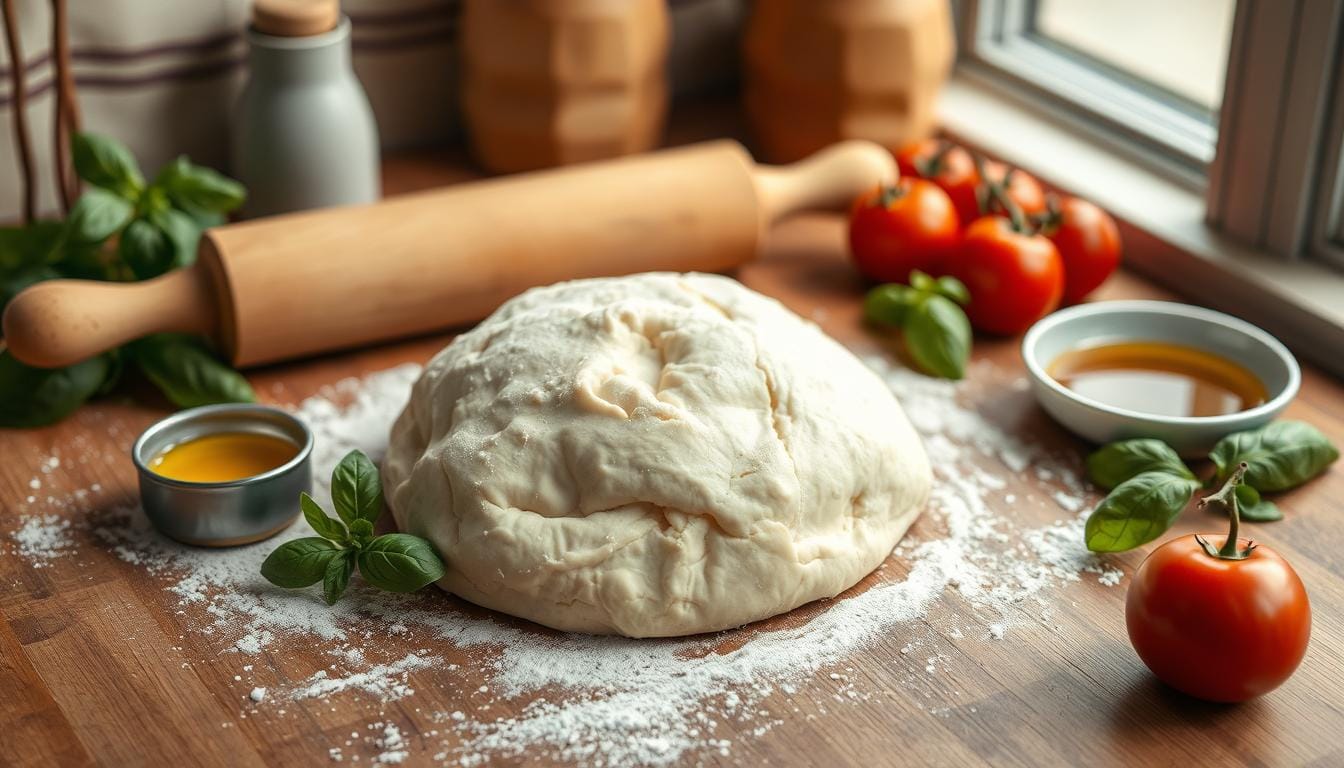Jump to Recipe
Making your own pizza dough from scratch is magical, isn’t it? The first time I tried it, I remember it like it was Sunday afternoon. I opted not to use store-bought dough on a cold Sunday afternoon and instead tried making my own pizza base.
When the smell of yeast and flour combined in my kitchen, it took me straight back to a charming pizzeria I visited in Naples. It was a surprise to me that this experiment would help me make the best pizza dough from scratch in my own home.
There are two excellent things about making your own pizza dough: it’s surprisingly simple and very satisfying. No more frozen options. Simple, all-purpose pizza dough transforms into a delicious, crispy base, eagerly awaiting your preferred toppings.
Get ready to make a masterpiece of a pizza with the rustic touch that can only come from making your own dough.
Why Make Pizza Dough at Home?

In addition to making tasty pizzas, making your own pizza dough at home has many benefits. Let me discuss some of the excellent benefits of making this tasty staple in your own kitchen.
Health Benefits of Homemade Pizza Dough
One great benefit of making your own pizza dough is that you can control what goes into it. When you make your own healthy pizza dough at home, you can use organic flours and natural yeast and avoid any additives or preservatives that you don’t want that are usually in store-bought dough.
By choosing the ingredients, you can meet dietary needs and make the food more nutritious, which is beneficial for your health. By taking control of the ingredients, you can also ensure the freshness and quality of the meals you prepare. For instance, exploring options like a vegan bibimbap recipe with gochujang allows you to create a flavorful, plant-based dish that is both satisfying and packed with nutrients. This not only caters to specific dietary preferences but also promotes a more balanced and mindful approach to eating.
Cost-Effective and Fun
Besides being beneficial for your health, making your own pizza can save you a lot of money. It’s much cheaper to make your own pizza dough than to buy pre-made dough or order pizza.
Making your own pizza dough is cost-effective because the ingredients are inexpensive and versatile enough to create multiple bases. Also, the process of making the dough can be a lot of fun.
When you cook at home, you feel like you’ve accomplished something special. Having pizza night with the family can be a fun, interactive activity that helps everyone be creative. Whether you’re shaping the dough or choosing the toppings, it turns a normal meal into a fun and memorable experience for everyone.
Ingredients for Homemade Pizza Dough
Getting the right pizza dough ingredients is the first step in making the perfect homemade pizza. Having the right ingredients in your kitchen pantry makes it simple to make fresh pizza dough, in my experience.
The following are simple pizza dough ingredients that you likely already have on hand:
- Strength of the flour: Strong bread flour will work best because it has more gluten, which gives the dough its chewy texture.
- Yeast: Active dry yeast works great, but instant yeast might be faster. Make sure the dough is fresh and active before it rises.
- Water: To get the yeast going, use warm water instead of hot water. The right temperature of water is crucial when making fresh pizza dough.
- Sugar: A little bit feeds the yeast, which helps the bread rise and makes the crust a little crispier.
- Salt: This makes the dough taste better and helps the gluten structure stay strong.
- Because it is rich, olive oil makes the dough more tender and flaky.
By paying attention to these pizza dough ingredients, you can make sure that any pizza has a tasty base. Remember that quality is important. Choosing the best makes fresh pizza dough easy.
Step-by-Step Guide to Making Pizza Dough

Making the perfect pizza dough at home is a relaxing activity. This tutorial on how to make pizza dough will walk you through every important step, making sure your dough is tasty and ready for your favorite toppings. Let’s get started, shall we?
Preparing Your Workspace
Setting up your work area is the first step in our pizza dough tutorial. Make sure a table or counter is clear and clean. You’ll need enough room to knead the dough without getting too tired. A measuring cup, a mixing bowl, and a clean, dry kitchen towel are some of the things you will need.
Mixing and Kneading the Dough
Here’s what you need to do to make dough: mix and knead it. In the bowl, mix the flour, yeast, salt, and water together. Mix the things together with your hands or a wooden spoon until you get a rough dough.
To begin the kneading dough technique, place the dough on a floured surface. With the heel of your hand, push the dough away from you. Then, fold it back toward you. Do this again and again for eight to ten minutes, or until the dough is smooth and stretchy.
Proofing the Dough
The next step is to proof the pizza dough. To get flavor and texture, this step is very important. Place the dough in a lightly greased bowl and cover it with a kitchen towel to allow it to rise. Make sure the bowl is somewhere warm and draft-free. The dough should double in size after this process, which takes about an hour to two hours.
Shaping Your Pizza Base
Now it’s time to make the pizza base. Once you’ve raised the dough, gently press it down to eliminate some air bubbles. Place the dough on a floured surface and cut it into as many pizzas as you want.
Make a ball from each piece and set it aside for a moment. You can use your hands or a rolling pin to flatten the dough. Start in the middle and work your way out. For the best pizza base, the goal is to get the thickness just right.
Tips for the Perfect Pizza Dough Texture

It can be challenging to get the right texture for pizza dough, but with a few simple tips, you can make your homemade pizza taste even better. Every step is very important, from choosing the right flour to getting good at knitting. Here’s how to really make your pizza dough stand out.
Choosing the Right Flour
Picking the right pizza flour is crucial for making the perfect pizza dough texture. Select ’00’ flour or strong bread flour because they have the right amount of gluten to make the bread strong and stretchy. This kind of flour helps make a crust that is chewy but soft, and it holds up well under the toppings without getting too tough.
Getting the Water Temperature Right
The temperature of the dough water is an important but often forgotten part of making the perfect dough. Warm water helps the yeast grow, which makes the texture smoother and more even. The water should be between 38 and 46 degrees Celsius. If it’s too hot, the yeast could die. If it’s too cold, the dough won’t rise right.
Proper Kneading Techniques
It’s important to knead pizza dough the right way so that gluten forms. Gluten gives the dough its structure and chewiness. To ensure proper dough development, push and fold the ingredients evenly for about 10 minutes.
The dough should get smooth, stretchy, and a little sticky when you touch it. When it stretches thinly without ripping and gently springs back when poked, you’ll know it’s ready.

Homemade Pizza Dough
Ingredients
- 3 ½ cups 450g strong bread flour (or '00' flour)
- 1 packet 7g active dry yeast
- 1 ¼ cups 300ml warm water (38-46°C)
- 1 tbsp olive oil
- 1 tsp salt
- 1 tsp sugar
Instructions
- Prepare your workspace: Clear a counter, and gather a mixing bowl, measuring cups, and a kitchen towel.
- Mix ingredients: In a bowl, combine flour, yeast, salt, and sugar. Gradually add warm water and olive oil. Stir until the dough begins to form.
- Knead the dough: Transfer the dough to a floured surface. Knead it for 8-10 minutes until smooth and elastic.
- Proof the dough: Place the dough in a lightly greased bowl, cover with a towel, and let it rise for 1-2 hours in a warm place until it doubles in size.
- Shape the dough: Once risen, press the dough gently to remove air. Divide into portions, roll into balls, and shape into pizza bases using your hands or a rolling pin.
Notes
- For a crispier crust, bake the pizza directly on a pizza stone.
- You can prepare the dough ahead of time and let it rise in the fridge overnight for even better flavor.
- Customize your pizza with any toppings you love—mozzarella, tomato sauce, pepperoni, vegetables, or herbs.
FAQ
What are the benefits of making homemade pizza dough?
Making pizza dough at home has a lot of benefits. It’s not only cheaper, but you can also control the quality of the ingredients. This makes the dough healthier because it doesn’t have any added sugars or preservatives. It’s also a relaxing activity that the whole family can participate in together.
What ingredients do I need to make easy pizza dough?
Some basic things you should have in your kitchen pantry to make pizza dough are olive oil, yeast, flour, water, and salt. Making sure your ingredients are fresh and correct will help you get the best results.
How do I prepare my workspace for making pizza dough?
First, make sure your workspace is neat and clean. Get all the bowls, measuring cups, and, if you have one, a stand mixer for the job. This will make the process go more smoothly.
What’s the proper technique for kneading pizza dough?
It is important to knead the dough the right way so that the gluten structure forms. This is what gives the dough its stretch. Place the dough onto a floured surface and thoroughly mix the ingredients. Push the dough away from you with the heel of your hand, then fold it back on itself. Do this again and again for about 10 minutes, or until the dough is smooth and stretchy.
How important is water temperature when making pizza dough?
Water temperature is crucial because it affects how yeast starts to work. The water should be just warm enough, between 40 and 45 degrees Celsius (105 and 115 degrees Fahrenheit). If it’s too hot, it can kill the yeast, and if it’s too cold, it won’t work right, which will stop the dough from rising.
What type of flour should I use for the perfect pizza dough texture?
It is important to use the right flour. Many people prefer strong bread flour due to its high gluten content, which enhances the dough’s flexibility and chewiness. For a more traditional Italian-style pizza, use ’00’ flour, finely ground to create a tender crust.
How long should I proof the pizza dough?
Different recipes call for different amounts of time to rise, but in general, you should give the dough at least one to two hours. It needs to get twice as big. You can also let the dough rise slowly in the fridge overnight, which can make it taste and feel better.
Any tips for shaping the pizza base?
Start by gently flattening the proofed dough on a floured surface to start making the pizza base. To make sure the thickness is even, press outwards from the middle with your fingertips. Handle the dough gently to avoid deflating it. To get a more even shape, you can use a rolling pin, but for a more traditional look, many people stretch the dough by hand.

